HONDA ACCORD SEDAN 2020 (in English) Owner's Guide
Manufacturer: HONDA, Model Year: 2020, Model line: ACCORD SEDAN, Model: HONDA ACCORD SEDAN 2020Pages: 728, PDF Size: 34.06 MB
Page 21 of 728
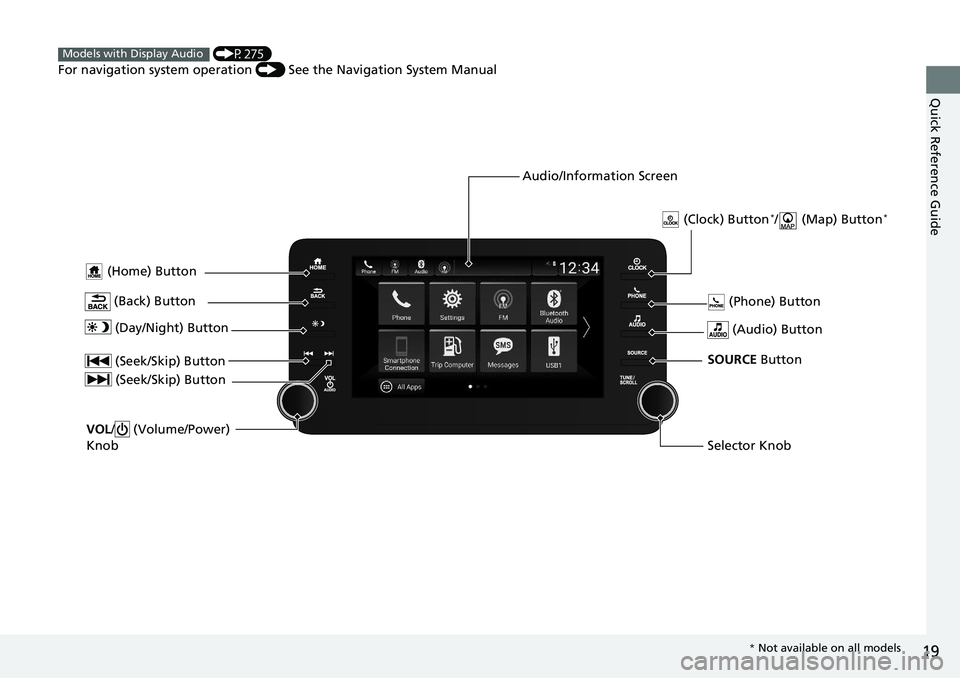
19
Quick Reference Guide
(Home) Button
(Audio) Button
(Back) Button
Audio/Information Screen
(P275)
For navigation system operation () See the Navigation System Manual
Models with Display Audio
(Phone) Button
(Day/Night) Button
(Seek/Skip) Button
(Seek/Skip) Button
VOL/ (Volume/Power)
Knob
Selector Knob SOURCE Button
(Clock) Button*/ (Map) Button*
* Not available on all models
Page 22 of 728
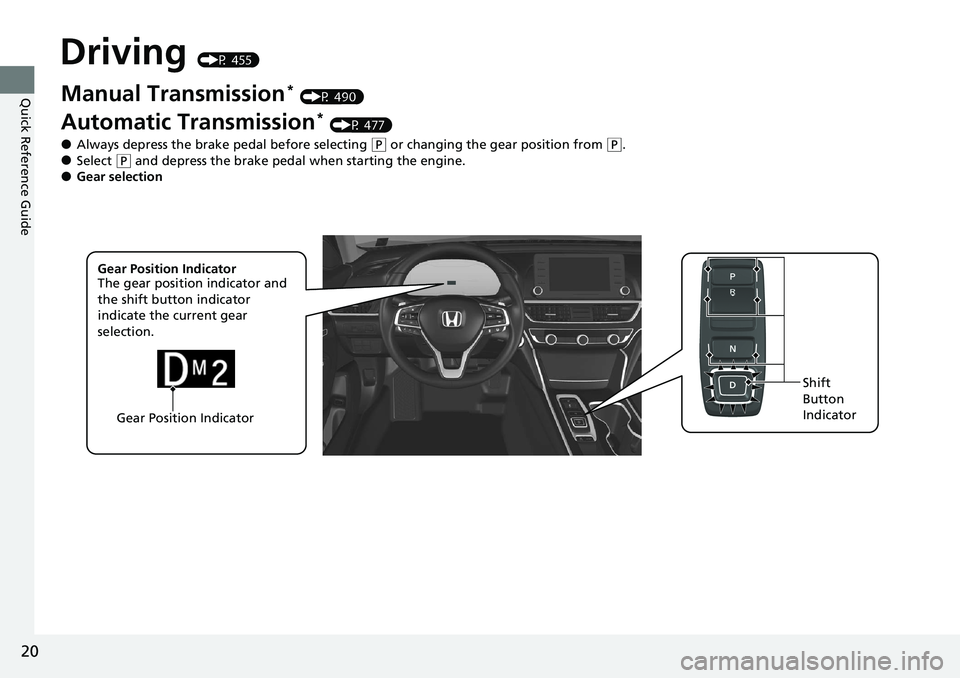
20
Quick Reference Guide
Driving (P 455)
Gear Position IndicatorShift
Button
Indicator
Manual Transmission* (P 490)
Automatic Transmission* (P 477)
●Always depress the brake pedal before selecting (
P or changing the gear position from (P.●Select (P and depress the brake pedal when starting the engine.●Gear selection
Gear Position Indicator
The gear position indicator and
the shift button indicator
indicate the current gear
selection.
Page 23 of 728
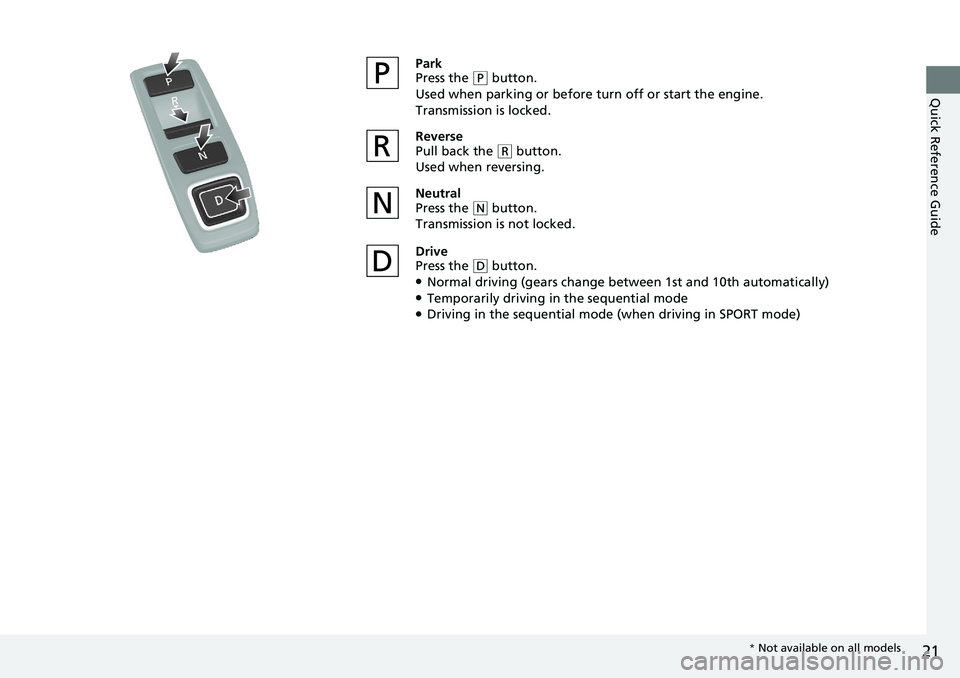
21
Quick Reference Guide
Park
Press the (P button.
Used when parking or before turn off or start the engine.
Transmission is locked.
Reverse
Pull back the
( R button.
Used when reversing.
Neutral
Press the
( N button.
Transmission is not locked.
Drive
Press the
( D button.●Normal driving (gears change between 1st and 10th automatically)●Temporarily driving in the sequential mode●Driving in the sequential mode (when driving in SPORT mode)
* Not available on all models
Page 24 of 728

22
Quick Reference Guide
M (sequential
mode)
Indicator
Gear Position Indicator
Shift Down
(-
Paddle Shifter Shift Up (
+
Paddle Shifter
Paddle Shifters (P482)●Paddle shifters allow you to sh ift gears much like a manual
transmission (1st through 10th). This is useful for engine braking.
When the transmission is in
(D●The transmission will shift back
to automatic mode once the
system detects that the vehicle
is cruising.
When the transm ission is in
(D with SPORT mode●Holds the selected gear, and
the M (sequential mode)
indicator comes on.
●The gear selection is shown in
the instrument panel.
Gear Selection Indicator
Page 25 of 728
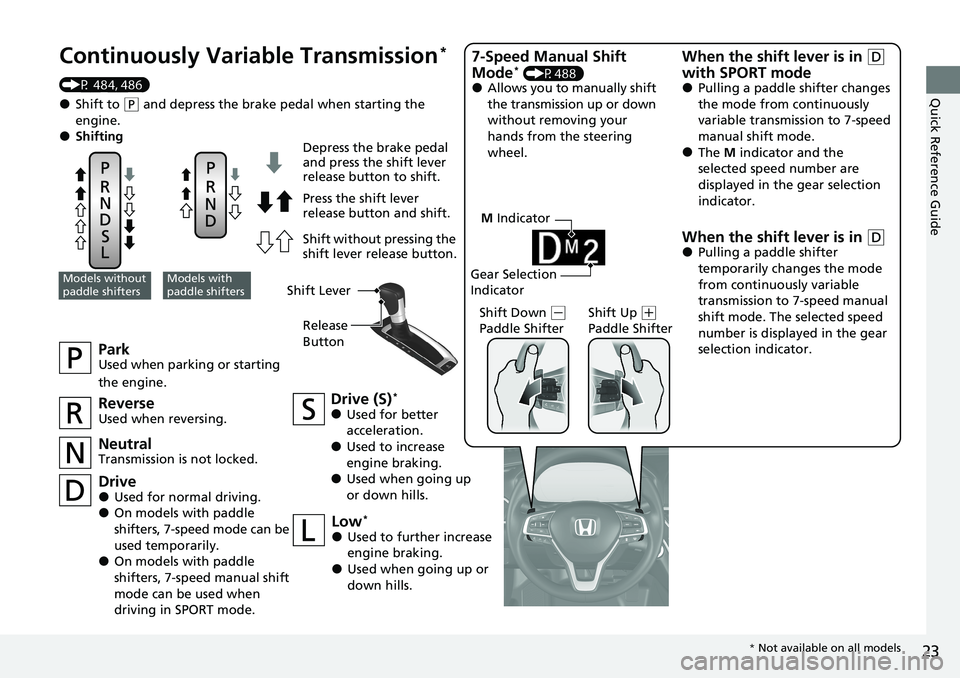
23
Quick Reference Guide
M Indicator
Gear Selection
Indicator
Continuously Vari able Transmission*
(P 484, 486)
●Shift to (P and depress the brake pedal when starting the
engine.
●Shifting
ParkUsed when parking or starting
the engine.
NeutralTransmission is not locked.
Drive (S)*
●Used for better
acceleration.
●Used to increase
engine braking.
●Used when going up
or down hills.
Models without
paddle shiftersModels with
paddle shifters
Depress the brake pedal
and press the shift lever
release button to shift.
Press the shift lever
release button and shift.
Shift without pressing the
shift lever release button.
ReverseUsed when reversing.
Drive●Used for normal driving.●On models with paddle
shifters, 7-speed mode can be
used temporarily.
●On models with paddle
shifters, 7-speed manual shift
mode can be used when
driving in SPORT mode.
Low*
●Used to further increase
engine braking.
●Used when going up or
down hills. Shift Down
(
-
Paddle Shifter Shift Up (
+
Paddle Shifter
7-Speed Manual Shift
Mode* (P488)●Allows you to manually shift
the transmission up or down
without removing your
hands from the steering
wheel.
When the shift lever is in (D
with SPORT mode
●Pulling a paddle shifter changes
the mode from continuously
variable transmission to 7-speed
manual shift mode.
●The M indicator and the
selected speed number are
displayed in the gear selection
indicator.
When the shift lever is in (D●Pulling a paddle shifter
temporarily changes the mode
from continuously variable
transmission to 7-speed manual
shift mode. The selected speed
number is displayed in the gear
selection indicator.
Shift Lever
Release
Button
* Not available on all models
Page 26 of 728
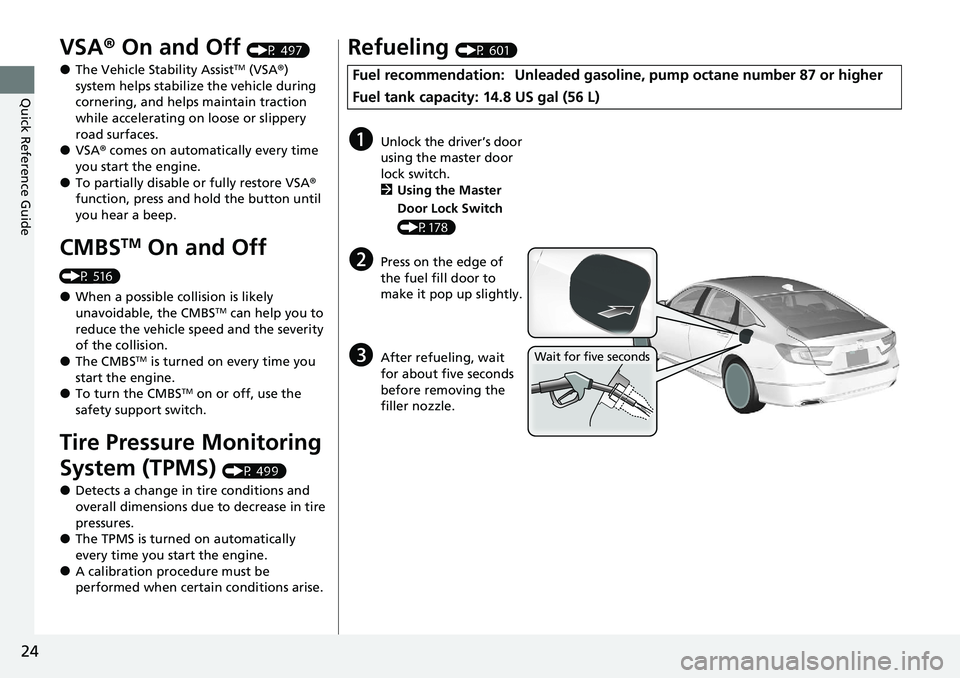
24
Quick Reference Guide
VSA® On and Off (P 497)
●The Vehicle Stability AssistTM (VSA ®)
system helps stabilize the vehicle during
cornering, and helps maintain traction
while accelerating on loose or slippery
road surfaces.
●VSA ® comes on automatically every time
you start the engine.
●To partially disable or fully restore VSA ®
function, press and ho ld the button until
you hear a beep.
CMBSTM On and Off
(P 516)
●When a possible collision is likely
unavoidable, the CMBSTM can help you to
reduce the vehicle sp eed and the severity
of the collision.
●The CMBSTM is turned on every time you
start the engine.
●To turn the CMBSTM on or off, use the
safety support switch.
Tire Pressure Monitoring
System (TPMS)
(P 499)
●Detects a change in tire conditions and
overall dimensions due to decrease in tire
pressures.
●The TPMS is turned on automatically
every time you start the engine.
●A calibration procedure must be
performed when certain conditions arise.
Refueling (P 601)
Fuel recommendation: Unleaded gasoli ne, pump octane number 87 or higher
Fuel tank capacity: 14.8 US gal (56 L)
aUnlock the driver’s door
using the master door
lock switch.
2 Using the Master
Door Lock Switch
(P178)
bPress on the edge of
the fuel fill door to
make it pop up slightly.
cAfter refueling, wait
for about five seconds
before removing the
filler nozzle.Wait for five seconds
Page 27 of 728
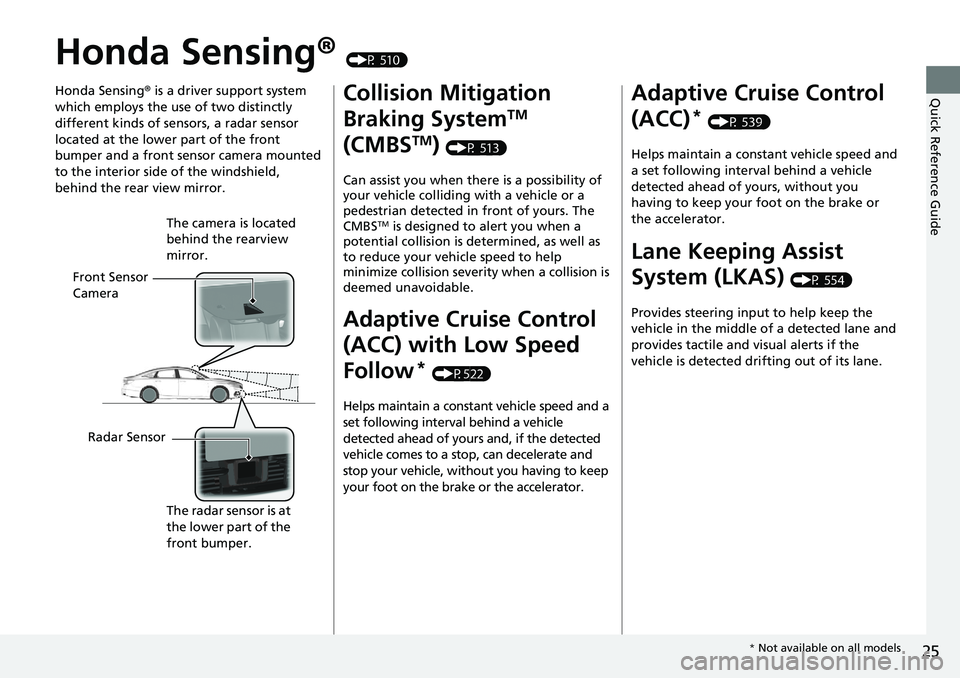
25
Quick Reference Guide
Honda Sensing® (P 510)
Honda Sensing ® is a driver support system
which employs the use of two distinctly
different kinds of sensors, a radar sensor
located at the lower part of the front
bumper and a front sensor camera mounted
to the interior side of the windshield,
behind the rear view mirror.
Front Sensor
Camera The camera is located
behind the rearview
mirror.
Radar Sensor The radar sensor is at
the lower part of the
front bumper.
Collision Mitigation
Braking System
TM
(CMBS
TM) (P 513)
Can assist you when there is a possibility of
your vehicle colliding with a vehicle or a
pedestrian detected in front of yours. The
CMBS
TM is designed to alert you when a
potential collision is determined, as well as
to reduce your vehicle speed to help
minimize collision severity when a collision is
deemed unavoidable.
Adaptive Cruise Control
(ACC) with Low Speed
Follow
* (P522)
Helps maintain a constant vehicle speed and a
set following interval behind a vehicle
detected ahead of yours and, if the detected
vehicle comes to a stop, can decelerate and
stop your vehicle, without you having to keep
your foot on the brake or the accelerator.
Adaptive Cruise Control
(ACC)
* (P 539)
Helps maintain a constant vehicle speed and
a set following interval behind a vehicle
detected ahead of yours, without you
having to keep your foot on the brake or
the accelerator.
Lane Keeping Assist
System (LKAS)
(P 554)
Provides steering input to help keep the
vehicle in the middle of a detected lane and
provides tactile and visual alerts if the
vehicle is detected drifting out of its lane.
* Not available on all models
Page 28 of 728
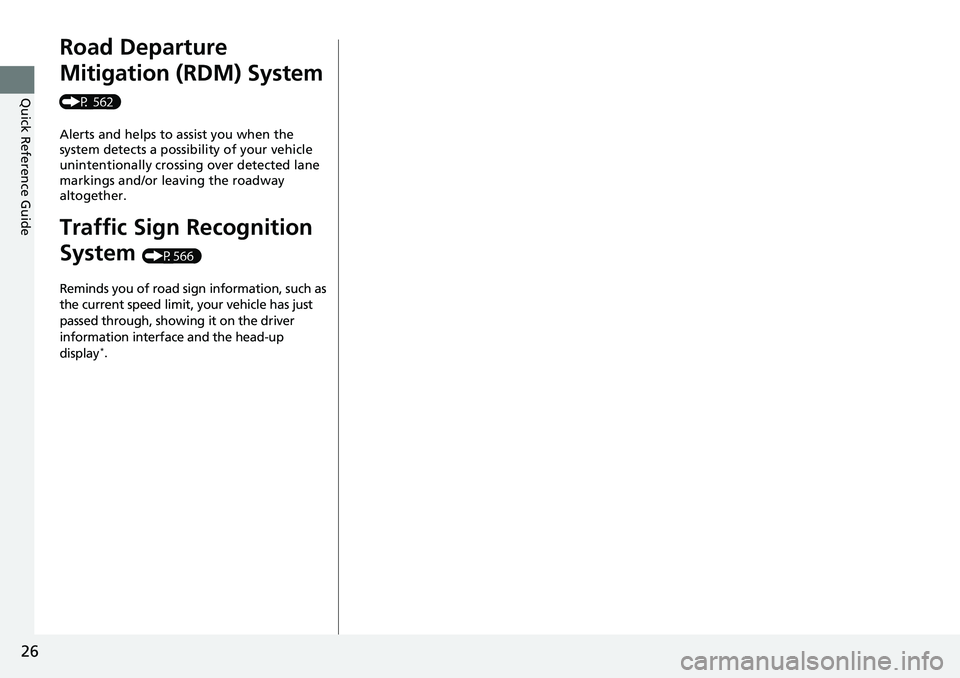
26
Quick Reference Guide
Road Departure
Mitigation (RDM) System
(P 562)Alerts and helps to assist you when the
system detects a possibility of your vehicle
unintentionally crossing over detected lane
markings and/or leaving the roadway
altogether.
Traffic Sign Recognition
System
(P566)
Reminds you of road sign information, such as
the current speed limit, your vehicle has just
passed through, showing it on the driver
information interface and the head-up
display
*.
Page 29 of 728
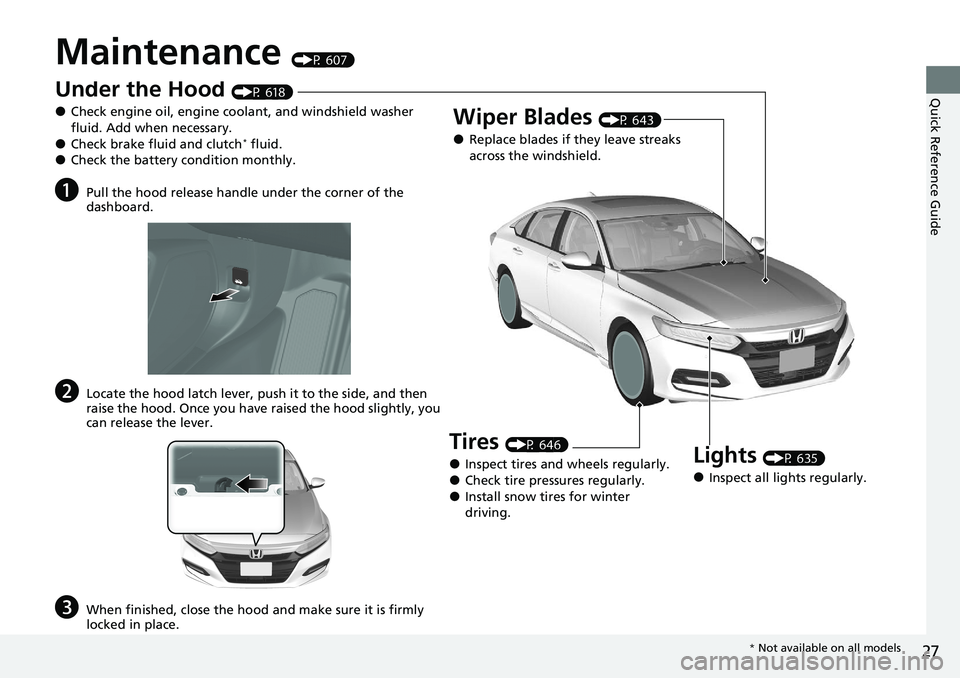
27
Quick Reference Guide
Maintenance (P 607)
Under the Hood (P 618)
●Check engine oil, engine coolant, and windshield washer
fluid. Add when necessary.
●Check brake fluid and clutch* fluid.●Check the battery condition monthly.
aPull the hood release handle under the corner of the
dashboard.
bLocate the hood latch lever, push it to the side, and then
raise the hood. Once you have raised the hood slightly, you
can release the lever.
cWhen finished, close the hood and make sure it is firmly
locked in place.
Lights (P 635)
●Inspect all lights regularly.
Wiper Blades (P 643)
●Replace blades if they leave streaks
across the windshield.
Tires (P 646)
●Inspect tires and wheels regularly.●Check tire pressures regularly.●Install snow tires for winter
driving.
* Not available on all models
Page 30 of 728
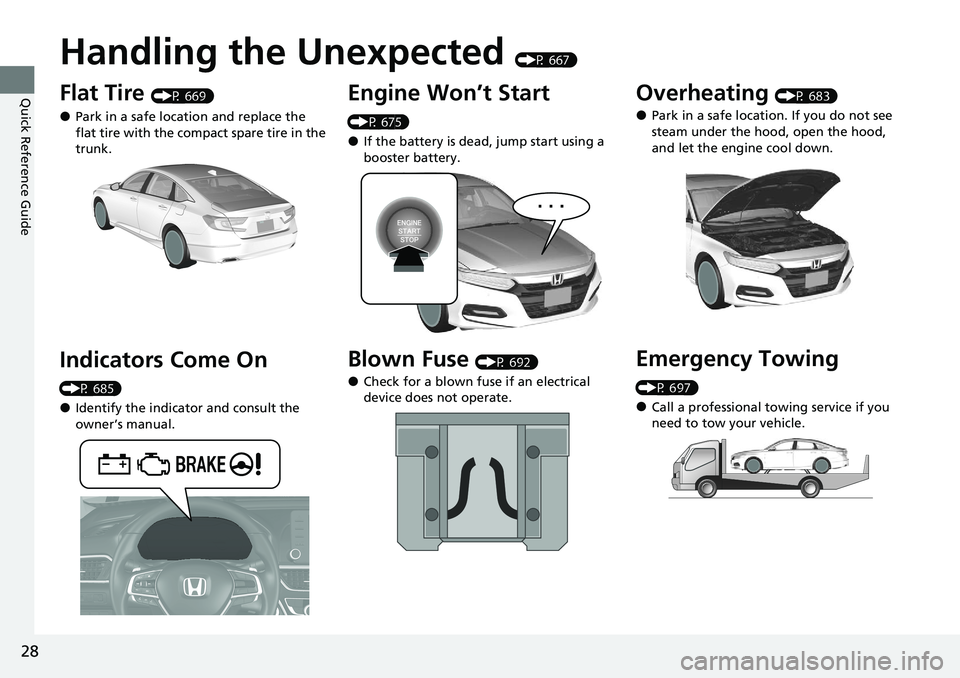
28
Quick Reference Guide
Handling the Unexpected (P 667)
Flat Tire (P 669)
●Park in a safe location and replace the
flat tire with the compact spare tire in the
trunk.
Indicators Come On
(P 685)
●Identify the indicator and consult the
owner’s manual.
Engine Won’t Start
(P 675)
●If the battery is dead, jump start using a
booster battery.
Blown Fuse (P 692)
●Check for a blown fuse if an electrical
device does not operate.
Overheating (P 683)
●Park in a safe location. If you do not see
steam under the hood, open the hood,
and let the engine cool down.
Emergency Towing
(P 697)
●Call a professional towing service if you
need to tow your vehicle.